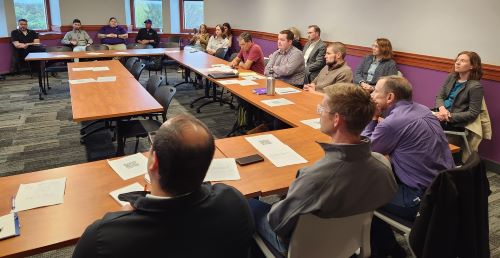May 20, 2024
K-State's National Agricultural Biosecurity Center recently hosted Foreign Animal Disease tabletop exercise

The National Agricultural Biosecurity Center, or NABC, at Kansas State University recently facilitated a campuswide engagement to help improve awareness, coordination and preparedness for how a Foreign Animal Disease, or FAD, will directly impact the university's ability to continue research, teaching and service involving livestock. As a land-grant institution, it is vital for the university to have planning in place for FAD response and recovery efforts.
Last year, NABC was awarded a grant by the United States Department of Agriculture, Animal and Plant Health Inspection Service, or USDA APHIS, through its National Animal Disease Preparedness and Response Program, or NADPRP, to develop a framework to guide Land Grant Institution Emergency Management beyond traditional, general higher education approaches to emergency management. NABC has been awarded a series of NADPRP grants totaling more than $421,000 beginning in 2019. The prior years' sections of work have included establishing tabletop exercises with county-level officials and Extension personnel across the state; evaluating secure food supply permitting processes; and develop livestock biosecurity plans for fairs and exhibitions.
NABC coordinated to bring together experts from the College of Agriculture, department of animal sciences and industry, College of Veterinary Medicine, Office of Research, Kansas State Veterinary Diagnostic Laboratory, and K-State Research and Extension to develop relevant scenarios allowing representatives from each unit to examine and practice any current FAD response planning. Additionally, attendees from the Division of Communications and Marketing, knowledge areas like public health, risk and compliance, systems engineering, financial planning, epidemiology and the Kansas Department of Agriculture took part in the learning opportunity.
"The level of expertise and partnership between the NABC, university faculty and staff, and State of Kansas partners during the FAD tabletop exercise was truly impressive," said Elliot Young, K-State assistant vice president, university risk and compliance officer. "The exercise is the latest example of the university's commitment to leading the nation in agriculture biosecurity and emergency preparedness efforts."
Taking a systems approach at integrating efforts at dispersed animal facilities belonging to the university, NABC's project has pursued creating an atmosphere of collaboration between colleges, departments and divisions that house livestock as part of their university mission spaces, as well as those departments and divisions that would be impacted by a high-consequence disease incident.
Aligning with K-State's reputation as a next-generation land-grant university and advancing agriculture industry stakeholders' priorities, the tabletop exercise and FAD response planning can be used as a template and guide for other land-grant institutions throughout the U.S. to continue the USDA APHIS mission to support animal agriculture sector training and exercise goals.
"It was great to have participation from university leadership and so many different departments and programs," said Nathan Brown, emergency management coordinator, Kansas Department of Agriculture. "Foreign Animal Disease is a difficult topic to discuss, but these conversations are vital to protect Kansas State University and our Kansas agricultural industry. These types of exercises help keep K-State a leading university in research and preparedness for Foreign Animal Disease response."
In the event of a FAD, the goal for land-grant institutions is to have planning that supports operational continuity for teaching and research. A FAD affecting cattle, swine, sheep, goats or poultry would disrupt operations with severe negative impacts, hindering the university's mission. Research and Extension units residing across the state would be constrained in providing support, research and local community outreach at expected levels of service and quality.
Funding for this project was through APHIS Cooperative Agreements and Grants Sponsor Award No: AP23VSSP0000C033. The National Animal Disease Preparedness and Response Program strengthens our country's ability to combat animal disease outbreaks. Through this program, APHIS provides tens of millions in funding to states, producer organizations, universities, and others to carry out high-value projects that help our nation prepare for the most critical animal health threats facing U.S. livestock industries today.
